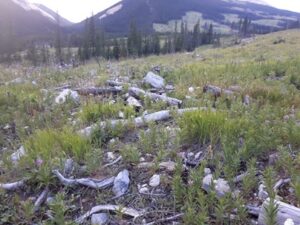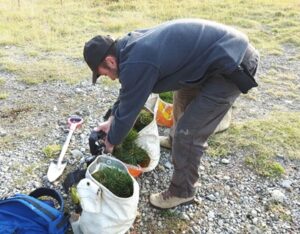Recovery & Restoration
Recovery & Restoration Projects
The Whitebark Pine Ecosystem Foundation of Canada supports, promotes, and conducts a variety of restoration and recovery activities. This includes working on species’ recovery plans, planning seed orchards, installing and monitoring long term and health plots, and of course planting seedlings. Below is a selection of some of the projects we are working on right now.

WPEFC couldn’t be more pleased to be working with Environment and Climate Change Canada on an Environmental Damages Fund-granted project. This program helps to restore the natural environment and conserves wildlife by supporting restoration and recovery of species and ecosystems. In this case, that means expanding mapping and restoration area assessment and selection tools to reflect the unique Canadian Rocky Mountain region. From there, WPEFC will use this logic model, to identify and treat priority restoration areas suitable for planting trees and increasing the number of healthy, reproductive trees on the landscape.

WPEFC is proud to be working with Natural Resources Canada and the 2 Billion Trees program. We were thrilled to be offered entry into this program when it first started in 2021, and to continue for the subsequent five years. WPEFC originally planted 62, 375 trees over 127 ha. Our new goal is to plant another 380,000 five-needled pines! This program is committed to nature-based climate solutions, and you can follow them at @2BillionTrees
The Columbia Basin Trust are stewards of the communities living in the Basin. They help maintain and improve ecological health and native biodiversity in a variety of ecosystems. The Trust is committed to working with organizations, communities and Indigenous peoples across the Basin to identify, plan and implement aquatic, wetland and terrestrial ecosystem enhancements; monitor the effectiveness of on-the-ground actions; and share best practices.
The Columbia Basin Trust is grateful to operate on the unceded traditional territories of the Ktunaxa, Lheidli T’enneh, Secwépemc, Sinixt and Syilx Nations, as is WPEFC.
One Tree at a Time
The Whitebark Pine Ecosystem Foundation of Canada supports, promotes, and conducts a variety of restoration and recovery activities. This includes working on species’ recovery plans, planning seed orchards, installing and monitoring long term and health plots, and of course planting seedlings. Here is a brief report from the field.
Slowly but Surely: Recovery for Alberta’s Whitebark and Limber Pine by Jodie Krakowski, Alberta Agriculture and Forestry
Nothing says “whitebark and limber pine restoration” like grunting up a steep slope loaded with heavy bags of seedlings! In late September 2020, 4400 whitebark and 1600 limber pine seedlings were planted to restore nearly 20 hectares of priority restoration areas in Alberta Crown land. These sites had high blister rust infection and mortality, with populations that are at risk of losing their ecological function without restoration planting of seedlings from trees selected for disease resistance.

A whitebark pine planting site on a reclaimed forestry road
All that sweat and dirt represents the culmination of years of work.
- First, stands are surveyed to find areas with high blister rust infection. Over 80% is preferred. Unfortunately, Alberta has lots of those!
- Then, plus trees that appear healthy or show signs of tolerance are identified, permanently tagged and documented.
- The stars must align so years when there is a good cone crop, resources and trained people are available to safely access and climb each tree twice to cage and then collect the cones.
- The seed is then manually extracted after cones are dried, and processed keeping each tree separate.
- The seed is then either stored for gene conservation, sent for disease resistance screening to a special facility, or sent to a nursery for a long, complex stratification process before sowing and growing.
- After 2 growing seasons, the seedlings are then packed and shipped to a remote area for planting.
- The planters need to overcome tough, rocky ground, steep and obstacle-filled terrain in order to find the best microsites to help these expensive seedlings survive.
- Monitoring plots are established to evaluate field performance and health of planted seedlings and compare screening results to field results.

Setting up a monitoring plot in a limber pine restoration site
Eventually these seedlings will contribute their own seeds, increasing the rust resistance of the population. Southwestern Alberta, in the heart of the Crown of the Continent, has extremely high levels of infection and mortality. Blister rust has been observed in whitebark and limber pine trees in the region for close to a century. Populations will lose their ecological function and connectivity without restoration to increase the population density and cone production.
While this may seem daunting, year by year, site by site, the cumulative results lead to recovery. There is no quick fix, but thanks to many partners, all the pieces of the provincial whitebark and limber pine recovery plan are being implemented.

Bagging up with whitebark pine plus tree seedlings
The long term, remote, costly nature of working with these species compels a careful balance between being pragmatic, opportunistic, and strategic. Between cones, funding, provincial and regional recovery priorities, logistics, and available resources, the options must be weighed each year, and for multi-year planning. There is always lots to do, and we expect the positive momentum will continue!
In 2020, partners supporting restoration included: Government of Alberta – Alberta Agriculture and Forestry and Alberta Environment and Parks, Environment and Climate Change Canada, the Whitebark Pine Ecosystem Foundation of Canada, Spray Lakes Sawmills, Riversdale Resources Limited, Gass + Associates, Hailey Mizera, Leor Katzev, Megan Evans, Colin McManus.






